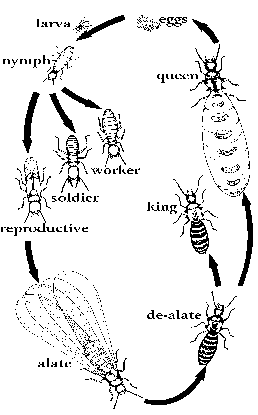
General
Information about Termites (2)
Termite Life
Cycle and Caste System
go to main menu
| The simplified model of a termite life cycle indicates the three castes, the reproductives, the soldiers and the workers. Due to the fact that termites are hemimetabolous insects, even the nymphs take part in the social life and have their specific tasks to fulfil. The so far poorly understood concept of caste determination does not seem to be definitive or too rigid. Once the caste of an individual is determined, development into other castes is still possible. Soldiers, also referred to as intercastes might turn into workers or even into reproductives, if there is a shortage of individuals of other castes. This process is controlled by pheromones. In the case of the queen, there is a specific ‘queen’ pheromone, preventing other individuals from turning into queens. Only if the queen is removed or dies, does the lack of the specific pheromone promote the development of a new queen. |  |
Reproductives possess compound eyes and are more or less brown due to their sclerotized cuticle. Developing reproductives have wing buds, wings or wing stumps. Reproductives can be further divided into:
|
|
| Workers are sterile, wingless and blind males and females. Their cuticle is unpigmented and not hardened, therefore the animals are confined to a dark and moist environment. Workers build the nest and galleries, they fetch food, care for the brood and feed reproductives and soldiers. The worker’s life span is one to two years. |
|
| Soldiers are, like workers sterile, wingless and blind males and females with an unpigmented, unsclerotized cuticle. Soldiers defend their colony from intruders by the use of powerful jaws and/or by ejecting a white sticky repellent from an opening on their head. Soldiers can’t feed themselves, they have to be fed by workers. Usually the number of soldiers is much smaller than the number of workers. Soldiers can be mandibulate or nasute, depending on the species. Therefore soldiers can be used for the identification of termite species. The life span of the soldiers is one to two years. |
|
(drawings reproduced from Hadlington, P., 1992)
go to previous page
go to main menu
© Michael F. Schneider, 1999